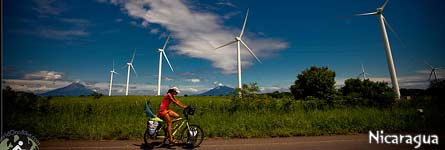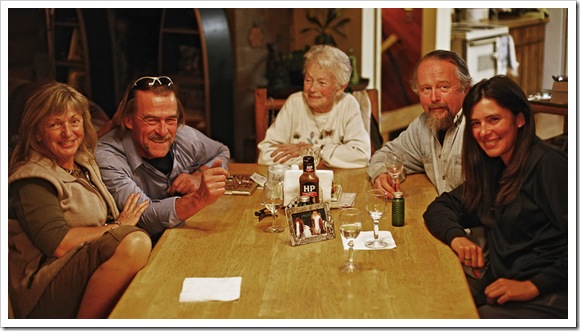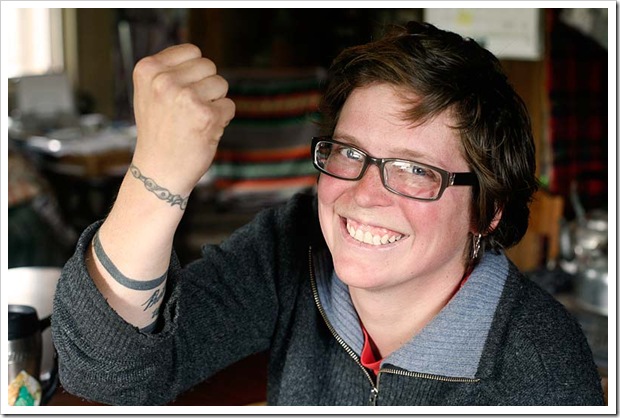Water: refill, not landfill please…
November 19, 2008 by Harry,
Filed under Tips & Tricks, Go green
 When cycling down from Alaska, we often asked passing RV’s for some water. We noticed that most of the time, people were carrying trays and trays of small 0.5l (16oz) bottles of water, which we normally refused. It appears that not many people are realizing that:
When cycling down from Alaska, we often asked passing RV’s for some water. We noticed that most of the time, people were carrying trays and trays of small 0.5l (16oz) bottles of water, which we normally refused. It appears that not many people are realizing that:
- You need about 3 liters/ 96oz of water per day, this means 6 empty bottles per person, so a lot of trash
- They pay much more for their water than they should
- Though many say bottled water is ‘safer’, they have no idea if the water is better than that from their taps as ‘sourced’ water does not have to disclose the ingredients…
- ‘Recycling‘ is merely downcycling (see the excellent book ‘Cradle To Cradle’): the bottles are not reused, they are just used as a low quality source for other products that also cannot be recycled, so just a few steps away from being landfill where they will end up..
It has become a habit to buy and take bottles of water (‘hey, water is healthy, right?‘), promoted by the powerful marketing machines of Pepsico & Coca-Cola and the shallow promise of ‘recycling’.
I can tell you that I have been using the same 2 bottles: 1 PolarBottle & 1 1liter waterbottle all the way from Northern Alaska to California. That’s right: just refills, with pure, delicious water. No trash needed… Here is some information that might educate and even surprise you a bit. Most of it is also sponsored by commercial companies like Nalgene (refillable bottles) & Brita (waterfilters), but I rather support those companies that try to pevent more trash.
On the side of this post is a small set of images; all shot within 20 minutes, while cycling uphill, all empty waterbottles, thrown out of cars by ‘healthy’ people…
Facts
| In the United States in 2006, bottled water consumption reached a record 8.3 billion gallons, 185 million gallons of which was imported. The total amount spent on bottled water was over $11 billion. (Beverage Marketing Corp.) | ||
| In contrast to tap water, which is distributed through an energy-efficient infrastructure, transporting bottled water long distances involves burning massive quantities of fossil fuels. Nearly a quarter of all bottled water crosses national borders to reach consumers, transported by boat, train, and truck. (Earth Policy Institute) | ||
| It costs more money to drink bottled water than to put gas in your car–up to five time more–due mainly to its packaging and transportation.(Earth Policy Institute) | ||
| Bottled water companies do not have to release their water-testing results to the public, whereas municipalities do. (Natural Resources Defense Council) |
Links
- Container Recycling Institute
- Earth Policy Institute
- National Resources Defense Council
- U.S. Environmental Protection Agency
- Bottled Water Blues
- Local Drinking Water Information. How is Your Tap Water?
- www.drinktap.org
(from http://www.refillnotlandfill.org/facts.html)
Learn the Facts
(from http://www.filterforgood.com/learn_the_facts.php)
Why is bottled water waste a concern? Here are just a few reasons…
- Americans used 50 billion water bottles in 2006 and sent 38 billion water bottles to landfills, the equivalent of 912 million gallons of oil.1, 2, 3, 4
- If laid end to end, that’s enough bottles to travel from the Earth to the Moon and back 10 times.5 If placed in a landfill or littered, those bottles could take up to 1,000 years to biodegrade.2
- The energy we waste using bottled water would be enough to power 190,000 homes.6
- In 2006, the average American used 167 disposable water bottles, but only recycled 38.1
- Americans used about 50 billion plastic water bottles in 2006. However, the U.S.’s recycling rate for plastic is only 23 percent, which means 38 billion water bottles – more than $1 billion worth of plastic – are wasted each year.1
Ditching bottled water keeps Mother Earth and your wallet green.
- One Brita pitcher filter can effectively replace as much as 300 standard 16.9-ounce bottles. So you can get great-tasting water without so much waste. Talk about refreshing.
- The average Brita pitcher filters 240 gallons of water a year for about 19 cents a day.7 Put in perspective, to get the same amount of water from bottled water would require 1,818 16.9-ounce water bottles a year.8
- For about $10 each, you can purchase a 16-ounce or 32-ounce Nalgene bottle, saving you hundreds of dollars a year on bottled water.
- Hydration at its best – carry the water you need and reduce your impact on the environment – one Nalgene bottle can last for decades, making it easy to stop buying single-serve bottled water to fulfill your everyday hydration needs.
Many people drink bottled water because they believe it to be of a higher quality, cleaner and better-tasting, but that’s not necessarily true.
- In the United States, 24 percent of bottled water sold is either Pepsi’s Aquafina (13 percent of the market) or Coke’s Dasani (11 percent of the market). Both brands are bottled, purified municipal water.1
- If you don’t like the taste of your tap water, try Brita. Nine out of 10 consumers say “Brita clearly tastes better,” according to an in-home usage study. They preferred the taste of Brita water – filtered through pitchers – to tap.9
- Dr. Gina Solomon, a senior scientist at the Natural Resources Defense Council, an environmental advocacy group, told The New York Times that “there is no reason to believe that bottled water is safer than tap water.”10
- In the U.S., public water is regulated by the Environmental Protection Agency (EPA), which requires multiple daily tests for bacteria and makes results available to the public. The Food and Drug Administration, which regulates bottled water, only requires weekly testing and does not share its findings with the EPA or the public.10
Notes/sources:
1. Fishman, Charles. “Message in a Bottle.” Fast Company Magazine July 2007: 110.
2. Arnold, Emily, and Janet Larsen. ” Bottled Water: Pouring Resources Down the Drain.” Earth Policy Institute. 2 Feb. 2006. 28 June 2007.
3. Larsen, Janet. “Bottled Water Boycotts:Back-to-the-Tap Movement Gains Momentum.” Earth policy Institute. 7 Dec. 2007.
4. One oil barrel = 42 gallons (Energy Policy & Planning Office, Ministry of Energy, Thailand)
5. The average 16.9-ounce bottle of water is 8 inches, or .67 feet, tall, meaning 38 billion bottles would cover 25,333,333,333.33 feet, or 4,797,979.80 miles. The distance from the Earth to the Moon is 238,987 miles, so 38 billion bottles could travel from the Earth to the Moon and back more than 10 times.
6. “Not Disposable Anymore.” P.O.V.’s Borders. 2004. PBS.
7. This cost assumes the purchase of a $25 pitcher (one filter included), plus 5 replacement filters at $9 each, for a total yearly cost of $70, or $0.19 cents a day.
8. Each filter produces 40 gallons of water and the average Brita owner uses 6 filters in a year, to produce 240 gallons, or 30,720 ounces, of fresh-filtered water. 30,720 ounces is equivalent to the water found in 1,818 16.9-ounce water bottles.
9. Brita Pitcher System In-Home-Use-Test compared to tap water. 2005
10. Burros, Marian. “Fighting the Tide, a Few Restaurants Tilt to Tap Water.” The New York Times [New York City, NY] 30 May 2007: Section F, Page 1.
« Previous: Tips from the road: Couchsurfing, WarmShowers & Hospitality Club «
» Next: 1000 Americans: Tom & Sandy Hubbard, Vancouver, WA »
You might also like
|
|
|
|
|









I enjoyed your comments on bottled water. Unfortunately, most (U.S.) Americans think only of convenience. The facts are very interesting and compelling. I plan on using them when Mike O’Toole speaks about Stewardship and the Environment at our Church. Hopefully, members of the community and parish can take a few ideas to heart. Keep up the great work and enjoy your time on the road. Elaine